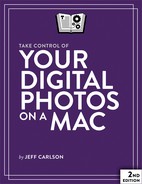Introduction
You probably have a story like this.
My mother took it upon herself to organize and digitize the family’s long-neglected stash of photos. Prints were pulled from proverbial shoeboxes, albums, and envelopes tucked in the backs of drawers. Black and white, sepia-tone, color; yellowed by age and old chemical processes; worn at the edges and vignetted in ways that today’s apps try so hard to emulate digitally.
Most details of the people and places in the pictures were lost or had changed over time, but she had an advantage: flipping the photos over often revealed valuable information about the shots, usually scribbled in pencil as an afterthought because the photographer or family member at the time knew who and what was depicted.
As we’ve embraced the digital photography revolution, there is nothing to flip over. The shots we capture are saved to memory cards and hard drives, and are infrequently printed.
And we’re shooting more. It’s now far easier to take photos because decent-quality cameras are inexpensive and pocketable. Top-rate camera technology is embedded into most cell phones; the iPhone, in fact, still ranks as the most popular camera at the photo-sharing site Flickr.
As a result, we’re drowning. No longer restricted by the length of frames on a film roll or the expense of paying to develop the bad shots along with the good, we capture many more photos.
But then what? Too often, the shots are dumped into a computer with the best of intentions for sorting and organizing, but are then left scarcely examined or enjoyed. Life intrudes, more photos are captured, and time passes until you need to locate some shots that you vaguely remember taking.
This is the point where you ask yourself, often in exasperation, “Why didn’t I organize these better? This shouldn’t be so difficult!”
And here’s where the new story begins.
Taking control of your digital photos isn’t impossible. Although we have more photos to deal with, we also have much better tools to describe and organize them. In fact, your camera and photo-management software can do some of the heavy lifting for you. By taking some deliberate steps before you go out shooting and when you import images, you’ll streamline what is normally a time-consuming task—making it more likely that you’ll do it. Best of all, you’ll be able to find images later without having to scan through every shot in your library. You’ll be able to “flip” the photos over and get the information you need.
The process I describe stakes out the middle ground between a completely hands-off approach (letting the software organize imported photos by time and date alone, or with the help of automatic image analysis) and the labor-intensive, detail-oriented approach taken by some professional photographers. Although my approach embraces liberal use of keywords and other metadata, it also focuses on saving time and reducing complexity to ensure you develop a system you’ll really follow each time. (By the way, many of these techniques apply to the ever-increasing number of videos in your library, too.) For those who would like to spend even less time managing photos, I offer some suggestions for modifying the process throughout the book.
What if you don’t want to go to even that little amount of trouble? This 2.1 version of the book addresses a new technological wrinkle: software features that analyze your photos for recognizable objects and assigns categories and tags—with no work on your part.
The other component of any modern photo-organization scheme is cloud services. As mobile devices have become constant companions, we’ve come to expect all of our data—from photos to calendars and contacts—to always be available. When I wrote the first edition, many services for accessing photos on multiple devices were just starting up (and some have since consolidated or disappeared). Now, the field is more stable—and more interesting. With services such as iCloud Photo Library and Google Photos, you really can access nearly every digital photo you’ve captured on every device you own (provided you’re aware of some important tradeoffs).
